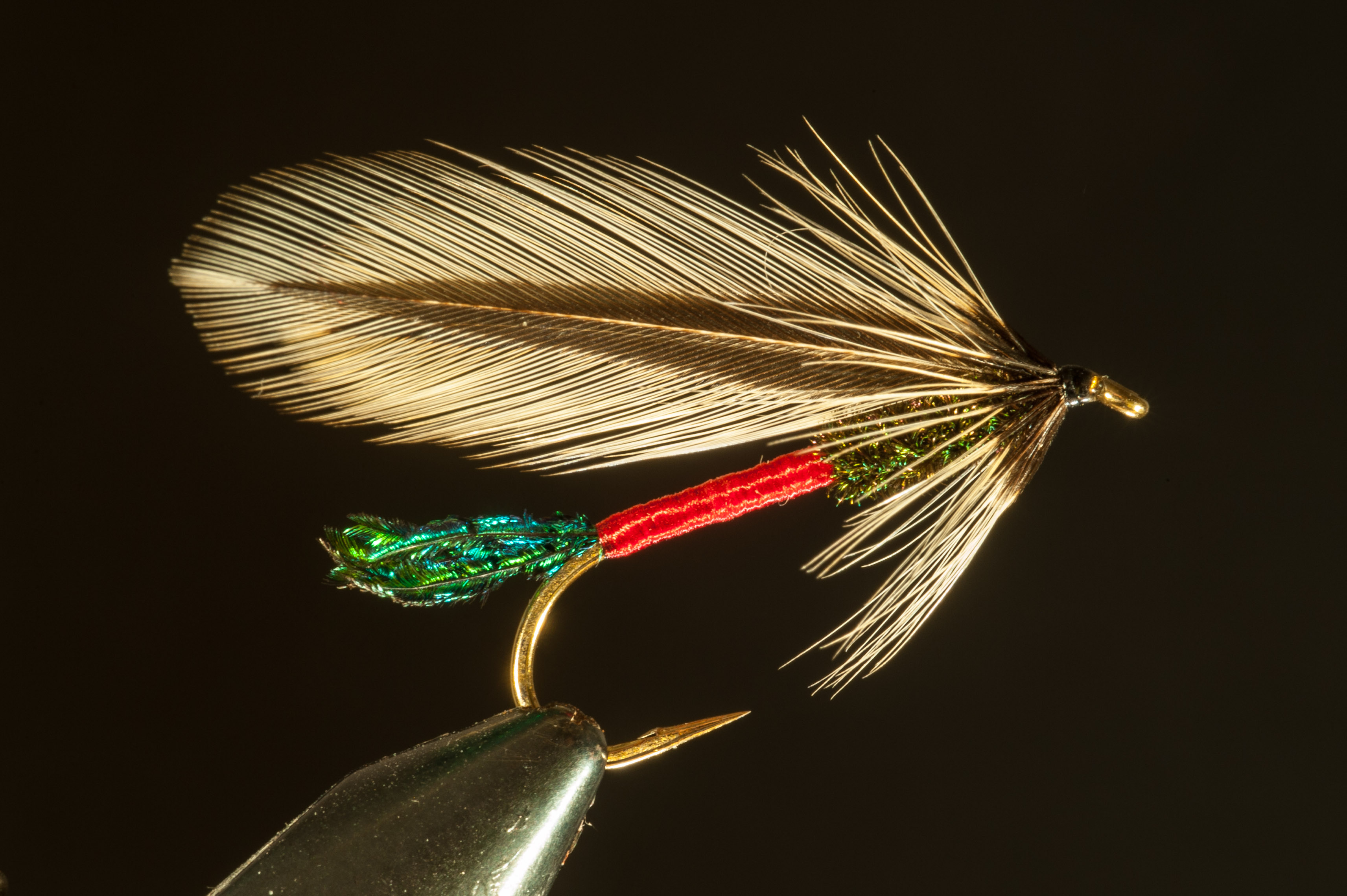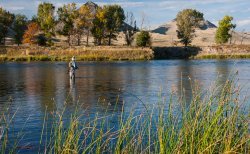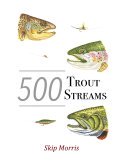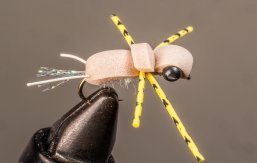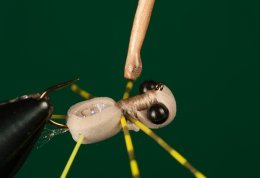Third Thursday Flies
6. Spruce Fly
with Skip Morris
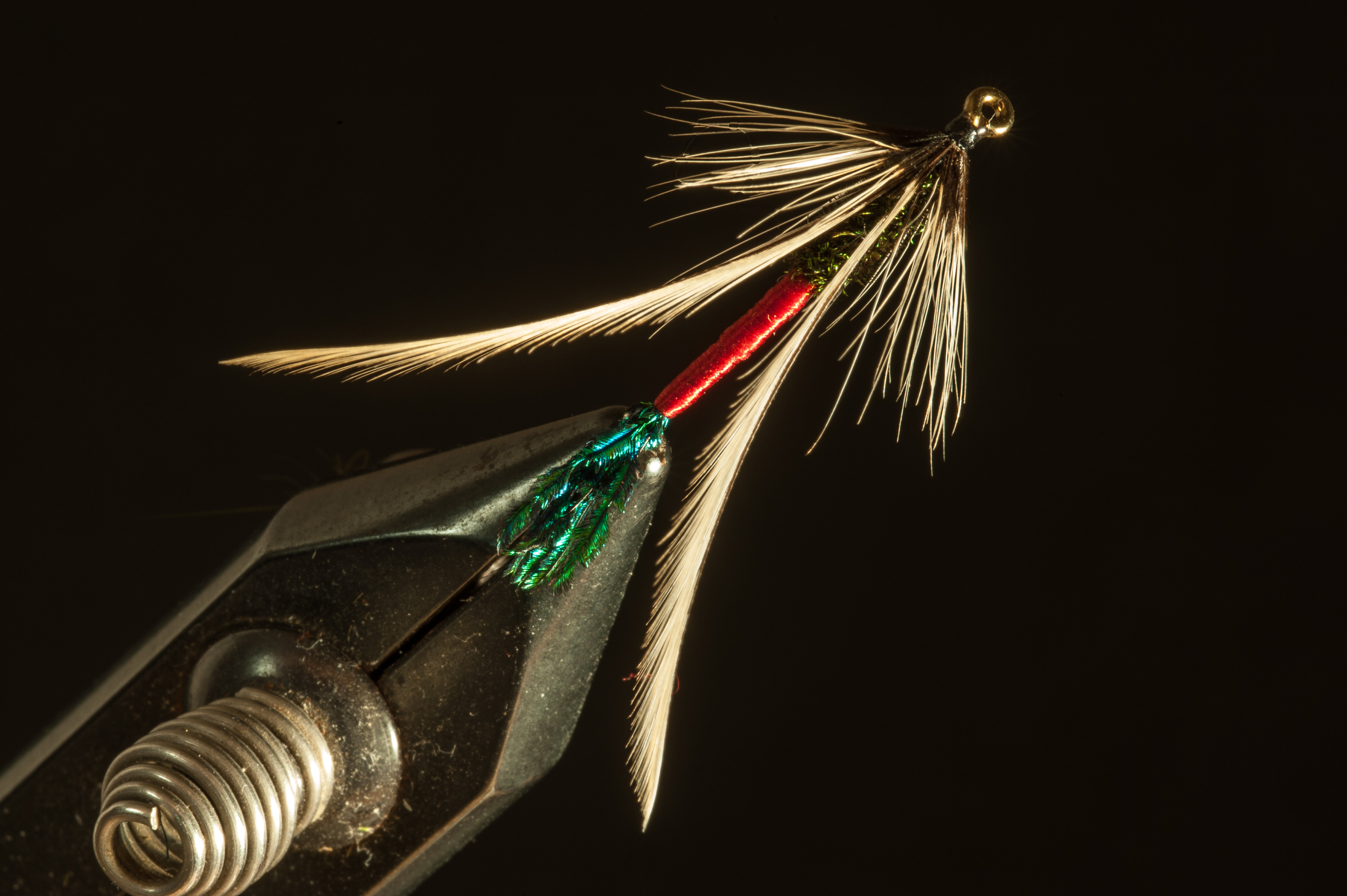 Split wings are so rare in trout streamers that perhaps only the Spruce's wings (and the wings of Spruce Fly variants) do that."
Split wings are so rare in trout streamers that perhaps only the Spruce's wings (and the wings of Spruce Fly variants) do that." (photos © Carol Ann Morris)
There are many handsome trout streamers—the Spruce Fly isn't unique in that—but there is something about the Spruce in particular that begs it be tied well. I think it's the sweet reward of seeing this dressing of such elegant potential all done right and perched beautiful and noble in the tying vise. Later, just as eye–pleasing in fly box and on tippet. Top, side, underside, oblique—there is no angle from which you can see this fly that it's not a real looker. A looker in the old way, of lovely natural materials which, specifically for the Spruce, are silky floss and soft–sparkling peacock herl and an unusual and intriguing kind of hackle for collar and wings.
That hackle, for a Spruce: when I looked around for it, it proved elusive. It's the badger hackle, which is cream or golden, and to be badger it must have an elongated black triangle running up its stem. I thought of ginger hackle because I was used to seeing the black triangle so common on brown dry–fly hackles. Big dry–fly neck hackles are typically a little soft and therefore can make good streamer wings and hackle collars. But most ginger hackles lack that black center—I just went down to my tying room, sorted through my half-dozen dry ginger necks to prove it, and did: the hackles of only one neck had the triangle.
Of course, there's always the permanent marking pen . . .
Badger was, in my long–ago youth, pretty popular. Now it, and flies calling for it, seem almost anomalies. The ideal for the Spruce is really good badger hen neck. So when my local fly shop tried to run one down for me and came up with two dandies, I bought them both.
Anyway, the fly's wing and collar of badger hackle are at most half of the fly's appeal. It's tail is unusual: naturally curving peacock sword herls, instead of the common, mostly straight, eyed–feather herls. And its red–floss–and–herl body is, in my experience, unique. (Yes, yes—red–floss–and–herl is what the Royals, the Royal Wulff and Royal Coachman and others, are all about. But their bodies are herl only banded by floss, whereas the Spruce has a long floss section behind a long section of herl. Quite different.) Then there's those otherwise classic swept–back long–hackle streamer wings, classic except . . . they curve not together but apart. Split wings are so rare in trout streamers that perhaps only the Spruce's wings (and the wings of Spruce Fly variants) do that.
The Spruce is an attractor and a trout catcher. And, like all attractor patterns, it's plain unnatural–name something in a trout stream that resembles the Spruce Fly and I'll be impressed. (Also a bit shocked. And concerned.)
I couldn't find much history on the Spruce Fly, and I tried. In Popular Fly Patterns (pub 1976) author Terry Hellekson says the fly came from an Oregonian, last name Godfrey. When? I don't know, none of my books say when Mr. Godfrey completed his elegant little construct. And that's it, all I could find. Apparently, the Spruce Fly's past is supposed to be none of my damned business.
The fly does have a few names, "Spruce Fly," in my experience, being the most common and the one I'll always use. It's also just called the "Spruce." And it's sometimes called the "Light Spruce," which makes sense as there's a less popular Dark Spruce.
The dressing varies too. One book offers a wire rib to protect the herl of the body (though I protect the herl by twisting it with the heavy tying thread). There's no agreement in my books on the relative lengths of herl and floss, but about 50/50 looks right to me and some books confirm that.
You don't have to know much about the Spruce Fly to make it work for you. Toss it out into a trout stream (usually on a sinking line, to carry the fly down) and then let the current swing it round. Twitch a little added action into the hackle and wings if you like as you strip it back, hoping a big rainbow or brown trout will find the Spruce Fly irresistible, as irresistible as I've always found it.
SPRUCE FLY somebody Godfrey
HOOK: Heavy wire, 2X to 4X long, sizes 10 to 4.
THREAD: Black 6/0 or 3/0.
TAIL: Peacock sword.
BODY: Rear one-third to two-thirds, red floss; front one third to two-thirds, peacock herl.
WING: Two (or four divided into two sets) badger hen hackles, curving apart.
HACKLE: Badger hen.
Click here to hear Skip's interviews on popular podcasts...
*Announcements*
Skip has an essay in Big Sky Journal's annual Fly Fishing issue, called "Montana Hoppers: the Princess and the Brute" released February 1, 2023. Skip rewrote it a bit; I painted and illustrated it here, on our website. Here's the link on our web page to check it out:
Click here to read Skip's essay Montana Hoppers: The Princess and the Brute...
Skip's latest books:
Top 12 Dry Flies for Trout Streams: How, When, and Where to Fish Them, is now available on Amazon as an ebook...check it out! Click on the links below to go to the information page on Top 12 Dry Flies (the link to Amazon is at the bottom of the page...)
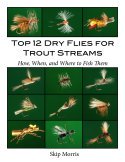 Top 12 Dry Flies for Trout Streams: How, When, and Where to Fish Them
Top 12 Dry Flies for Trout Streams: How, When, and Where to Fish Them
Click here to get more information about
Top 12 Dry Flies for Trout Streams: How, When, and Where to Fish Them (the link to Amazon is at the bottom of the page)...
Top 12 Dry Flies for Trout Streams: How, When, and Where to Fish Them (the link to Amazon is at the bottom of the page)...
Top 12 Nymphs for Trout Streams: How, When, and Where to Fish Them, 2nd Edition, originally published as an e-book only, is now available on Amazon as a paperback...check it out! Click on the links below to go to the information page on Top 12 Nymphs (the link to Amazon is at the bottom of the page...)
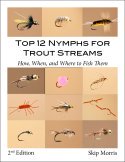 Top 12 Nymphs for Trout Streams: How, When, and Where to Fish Them (2nd Edition)
Top 12 Nymphs for Trout Streams: How, When, and Where to Fish Them (2nd Edition)
Click here to get more information about
Top 12 Nymphs for Trout Streams: How, When, and Where to Fish Them (2nd Edition). . .
Top 12 Nymphs for Trout Streams: How, When, and Where to Fish Them (2nd Edition). . .
Click here to get more information about Skip's e-book,
500 Trout Streams...
500 Trout Streams...
Skip's latest paperback book:
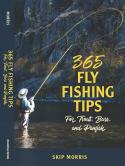 365 Fly Fishing Tips for Trout, Bass, and Panfish
365 Fly Fishing Tips for Trout, Bass, and Panfish
Click here to get more information about Skip's latest book,
365 Tips for Trout, Bass, and Panfish...
365 Tips for Trout, Bass, and Panfish...
Print Skip's chart for FREE:
Skip Morris's Trout-Fly Proportion Chart
Go to Skip Morris's Trout Fly Proportion Chart
Skip's Predator is available to buy...
Skip's ultra-popular Predator—a hit fly for bluegills and other panfishes and largemouth bass (also catches smallmouth bass and trout)—is being tied commercially by the Solitude Fly Company.
The Predator
CLICK HERE to learn more about or to purchase the Predator...
Learn to Tie Skip's Predator
Do you want to tie the Predator?
Tying the Predator
Skip shows you how to tie it on his YouTube Channel link, listed below:
CLICK HERE to see Skip's detailed video on how to tie the Predator...
